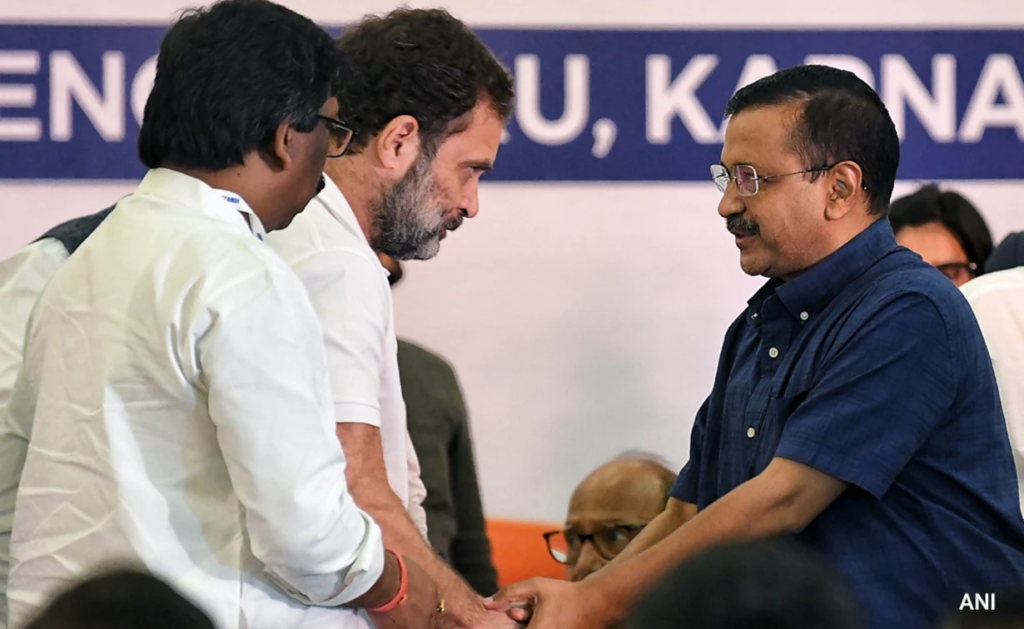Congress-AAP Alliance Shakes
In a significant development for Indian politics, the Congress and the Aam Aadmi Party (AAP) are reportedly finalizing a deal to divide the seven Lok Sabha seats in Delhi, marking a pivotal moment in the country’s electoral landscape. This follows closely on the heels of the Congress‘ agreement with the Samajwadi Party (SP) for a seat-sharing arrangement in Uttar Pradesh, a state with 80 parliamentary constituencies, signifying the first major collaboration within the Indian opposition bloc.

The potential agreement between the Congress and the AAP, two prominent opposition parties, holds immense significance as it underscores a strategic move aimed at consolidating their electoral prospects. Sources indicate that the proposed deal entails a four-three split in favor of the AAP, highlighting a calculated effort to optimize each party’s strengths in Delhi’s political arena.
While an official statement confirming the alliance is anticipated imminently, if realized, it would represent a substantial leap forward for the Congress-led coalition, which has been grappling to gain momentum with the general elections looming on the horizon.
However, the implications of the Congress-AAP alliance extend beyond the confines of Delhi, raising questions about its potential to influence the political landscape in neighboring states. The unresolved deadlock in Punjab, for instance, remains a subject of speculation, with the alliance’s impact on the state’s dynamics yet to be fully determined. Despite initial hopes of reaching a consensus, recent statements by AAP leader Arvind Kejriwal asserting the party’s intent to contest independently in Punjab have complicated the situation, hinting at underlying tensions within the opposition bloc.
Kejriwal’s declaration, coupled with his criticism of the previous administration’s track record in Punjab, underscores the intricacies involved in forging alliances and navigating political alliances in a diverse and complex electoral landscape. Moreover, the AAP’s decision to field a candidate in Chandigarh, currently held by the BJP, adds another layer of complexity to the evolving political equations in the region.
The failure to find common ground in Punjab highlights broader challenges facing the opposition coalition, particularly concerning the alignment of smaller regional parties with the Congress. Internal dissent and opposition from state leaders further complicate efforts to consolidate the opposition bloc, as evidenced by statements from senior Congress leaders expressing reservations about forming an alliance in Punjab.
The formation of the opposition bloc, conceived with the aim of unifying disparate political forces to challenge the dominance of Prime Minister Narendra Modi and the Bharatiya Janata Party (BJP), has encountered setbacks and obstacles along the way. The defection of key members, such as Bihar Chief Minister Nitish Kumar’s Janata Dal (United) and the potential departure of Jayant Chaudhary’s Rashtra Lok Dal to the BJP, underscore the fluidity and volatility of political alliances in India’s dynamic political landscape.
Furthermore, the withdrawal of West Bengal’s Trinamool Congress from active participation in the opposition coalition, citing disagreements and personal attacks, further underscores the challenges of sustaining cohesive alliances amidst divergent political agendas and strategies.
The recent agreement between the Congress and the Samajwadi Party in Uttar Pradesh, once deemed improbable, illustrates the potential for reconciliation and collaboration within the opposition ranks. The intervention of key leaders, notably Priyanka Gandhi Vadra, in negotiating the terms of the agreement underscores the significance of personal diplomacy and strategic maneuvering in shaping political alliances.
The proposed seat-sharing arrangement in Uttar Pradesh, with the Congress securing key constituencies such as Raebareli, Amethi, and Varanasi, represents a strategic coup for the opposition coalition, positioning them favorably in a state crucial to electoral fortunes.
As speculation mounts regarding potential candidates and electoral strategies, the forthcoming elections are poised to witness intense competition and strategic maneuvering as political parties jockey for power and influence. The emergence of new alliances and realignments underscores the dynamic nature of Indian politics, characterized by shifting alliances and evolving electoral dynamics.
In conclusion, the Congress-AAP alliance and the broader developments within the opposition bloc signal a paradigm shift in Indian politics, with implications that extend far beyond electoral arithmetic. As the countdown to the general elections begins, the stage is set for a high-stakes political showdown, with alliances, strategies, and personalities shaping the contours of India’s democratic landscape.

[…] Lawmakers-Alabama lawmakers are currently grappling with the aftermath of a landmark ruling by the state’s Supreme Court, which declared that […]